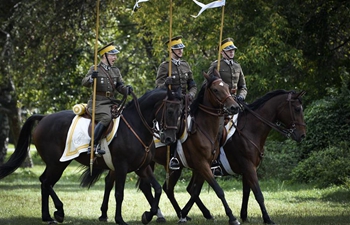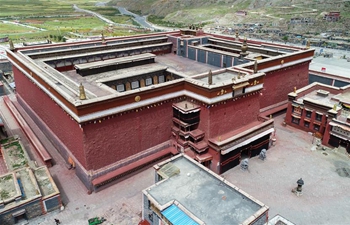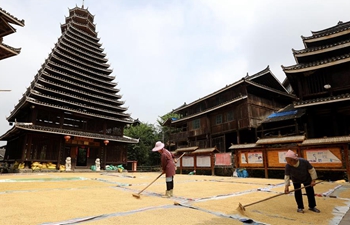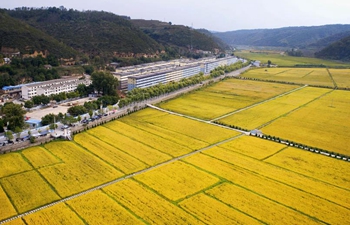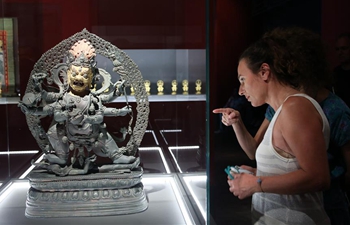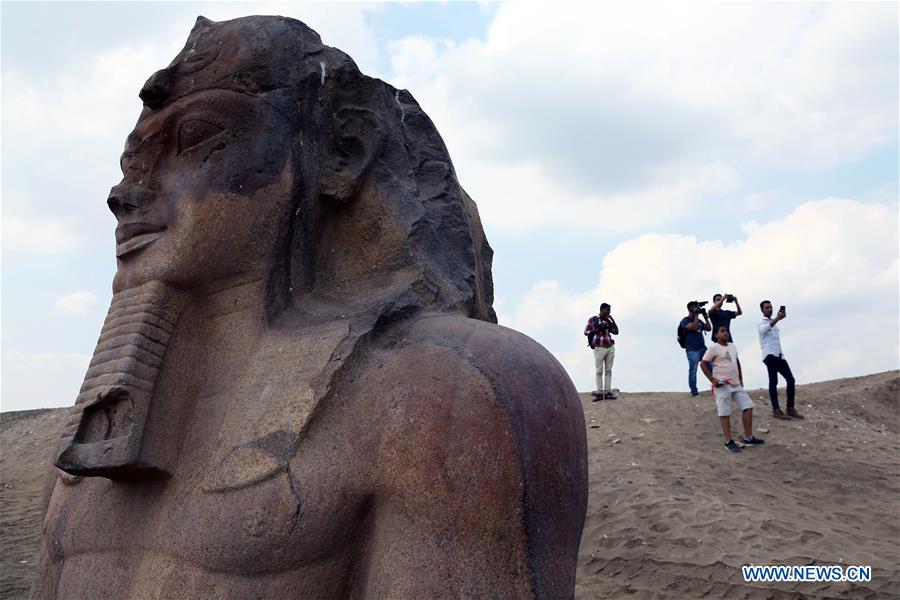
People visit an open-air museum in Sharqiya, Egypt, on Sept. 15, 2018. Some 130 kilometers away from the Egyptian capital Cairo, work continued to revive the north capital of ancient Egypt, San al-Hagar or Tanis and to turn it into an open-air museum. (Xinhua/Ahmed Gomaa)
by Marwa Yahya
SHARQIYA, Egypt, Sept. 16 (Xinhua) -- Some 130 kilometers away from the Egyptian capital Cairo, work continued to revive the north capital of ancient Egypt, San al-Hagar or Tanis and to turn it into an open-air museum.
The ongoing work aimed to put into place the monumental blocks, columns and statues that have been laying on sands since their discovery in the 19th century, Egyptian Antiquities Minister Khaled al-Anany said during an inspection tour to the Tanis site on Saturday.
Over the past few weeks, Egyptian workers have reerected two big columns, two obelisks, and colossal statutes of Ramses II, he added.
Tanis boasts many monumental relics and is one of the country's largest and most impressive historic sites. Egyptologists have dubbed it the "Luxor of the North."
At the end of the New kingdom in 11th century B.C., Egypt has entered a period of division. To the North, the rulers of the 21st dynasty built a new capital city, Tanis. Their power did not extend beyond Lower Egypt. To the South, the powerful High Priests of Amun were controlling Upper Egypt from the ancient city of Thebes (today's Luxor).
"Tanis is Thebes of the north. It contained temples of Amun, Mut and Khonsu," al-Anany said, noting that the site has gone through many archeological works starting from 1722.
Excavation by the French archaeologist Pierre Montet between the 1920s and 1950s were considered the most important, as it unearthed the royal necropolis of the 21st and the 22nd dynasties in 1939. The unique treasures are now on display in the Egyptian Museum in downtown Cairo.
In December 2017, the Supreme Council of Antiquities decided to resume work in the site after the last mission finished its excavation and restoration activities in 1965, according to the minister.
"We are only starting. We put the monuments on stone mounts to isolate them from the ground and to protect them from subsoil water, salts and moisture, and to better display the artifacts," the minister added.
Mitwally Saleh, manager of Tanis archeological site, said the Egyptian missions to rescue and revive the monuments of Tanis site have gone a long time of uncompleted stages.
The Tanis site includes houses gates, ritual wells, royal necropolis, tombs, obelisks, colossi, sanctuary area, sacred lake of Amun and Khnsu temple area, columns, Horus temple and Mut temple, according to Saleh.
Rescue work first started in Amun temple from the gate which was decorated with two statues of king Ramses II in poor conditions, Saleh said.
"With the help of the researchers, archeologists and even residents, we managed to restore two statues and put them at the gate of the temple with one looking to the east and the other to the west as they were in ancient times," he added.
The Amun temple is 300-meter-long and 200-meter-wide. The ongoing work includes the walls, the houses of the priests and servants the sacred lake, Saleh said.
More than 20,000 pieces from the temple will be displayed in a very huge museum in near future, he added.
"I feel very proud to be part of the rescue work in Egypt Delta Capital as my father was a member of the mission to restore Luxor temples," said Mahmoud Saleety, a senior worker in the famous Karnak Temple who came to Tanis with his team.
"Lifting and restoring one statue took seven days of my clever team. However, it took two days for building the base of one obelisk and reerected it, while the column took only one day," he told Xinhua.
"We finished two obelisks and plan to finish another 12 in the coming few months and to restore four statutes," he added.
"Tanis archaeological site will surely amaze local and global tourists, as it contains one third of Egypt's artifacts," said al-Anany.

